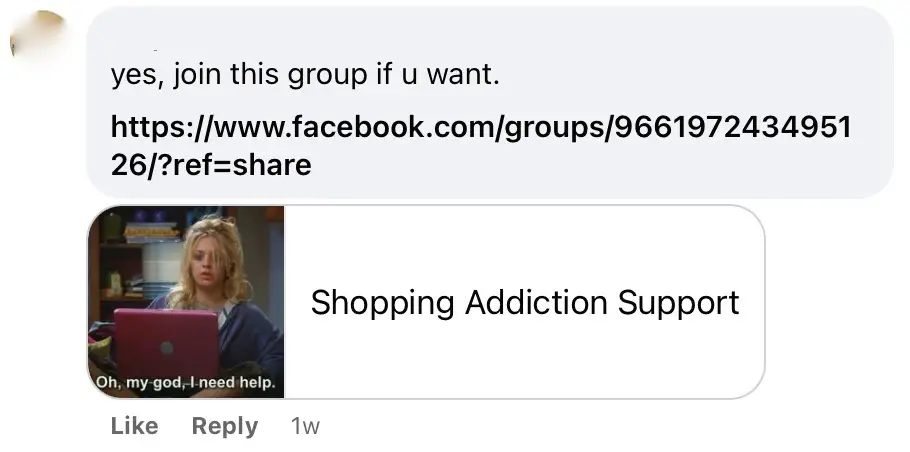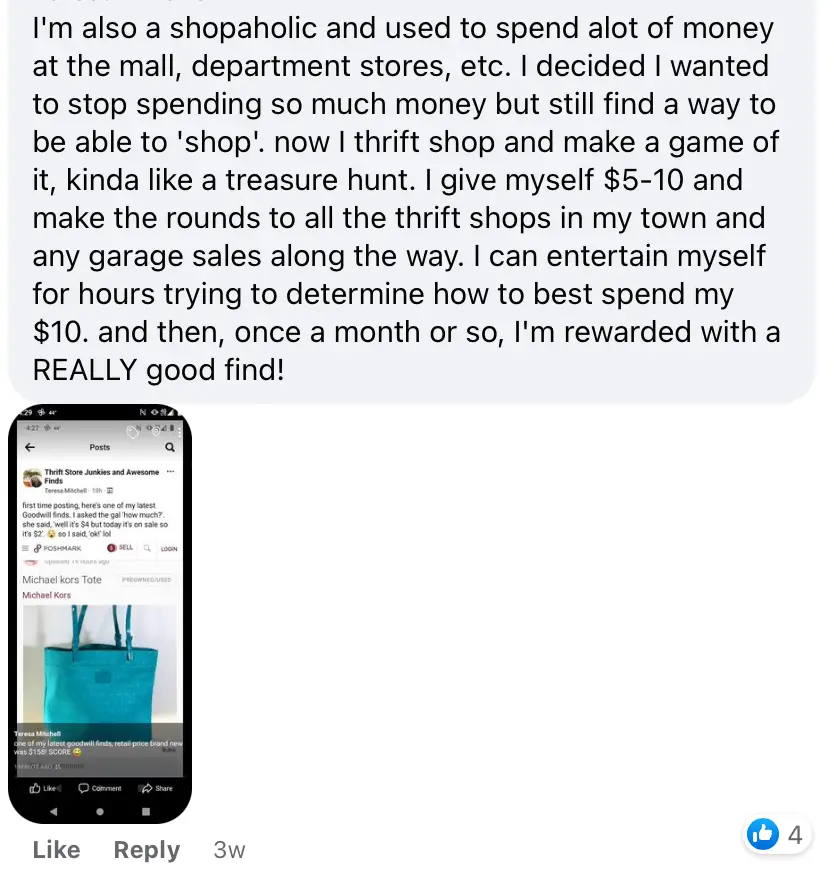Recently, I had a friend confide in me about her overspending problem. She wanted to stop buying stuff she didn’t need, but wasn’t sure where to start.
While I’ve definitely struggled in my finances, I’ve always been a natural-born, frugal living saver. I wasn’t quite sure what to say to my friend, so I asked 50 former (or still in recovery) shopaholics about what worked for them, and was surprised by what I found.
Most of the respondents listed multiple strategies that helped them stop buying so much, which is reflected in the percentages below. (You’ll notice they don’t all add up to 100%.) I’ve also used their own words in many places here, but have removed their names to protect their identities.
Here’s the collective wisdom of 50 former shopaholics, in increasing order of how often the tip was recommended.
How to Stop Buying Unnecessary Things
1. Reframe your thinking
8% of respondents described changing thought patterns as helpful. This ranged from small changes, like reading or watching youtube stories of others who’ve kicked the habit, to learning about the effects of “fast fashion” on the environment.
Most of all though, I heard people describing new affirmations they told themselves to get them on the right path. I thought they were worth sharing.

- “I still look good in the clothes I have.”
- “I want to make myself rich, not the big companies.”
- “It’s ok to wear clothes more than once.”
- “I have enough.”
- “I’m happier having a bigger net worth than I am shopping all the time.”
- “I can be a smart shopper without shopping every deal or sale.”
2. Do some soul searching
10% of former shopaholics who responded to my survey questions reported that some kind of personal reflection was important when they stopped buying so much. They suggested some great ideas.

- Figure out WHY you’re overspending. Are you insecure in some way? Are you trying to avoid uncomfortable thoughts (trauma, anxiety, stress, boredom, guilt, etc)?
- What places, times, or websites that give you the urge to shop most?
- Are there any “trigger” events (bad day at work, thinking about a memory, etc) that make you want to shop?
- Train yourself to ask if each purchase is a ‘want’ or a ‘need,’ and defend your answers to yourself.
- Ask yourself if your shopping habits might be a shopping addiction that could benefit from professional help. (Shopping addiction affects more than one in 20 Americans, and it is treatable!)
3. Make a shopping battle plan
12% of my former shopaholic survey-takers said they created a kind of “battle plan” to help them stop buying stuff. I was surprised to see that some of their strategies were ones I did naturally to save money myself.

- Plan specific shopping times, and never go when you’re just bored, upset, or feeling insecure.
- Shop with a list, and only buy what’s on it.
- Bring cash and only cash when you need to go shopping. No emergency debit cards or credit cards. When the cash is gone, it’s gone.
- Don’t ever purchase something the same day you put it in your online cart. Instead, make a rule that you can’t hit that “buy now” button until at least 24 hours (or 48 hours, or a whole week, or whatever you decide) have passed.
4. Get allies
14% of respondents mentioned allies they’ve found on the journey. These are some of their suggestions.

- Get an accountability partner who’s both willing and able to help you. This could be a spouse, a parent, friend, or even an adult child. They need to be loving but firm in helping you stick to your goals without forcing you to do anything.
- Find like-minded friends online who can swap tips and celebrate your successes with you.
- In addition, find IRL friends who will hang out with you at places other than the mall or Target. Invite friends over for coffee to chat, or plan something like a board game or at-home karaoke night.
5. Face reality
20% of respondents said it was important to get a clear picture of reality before moving forward. To many, this meant not only taking a good look at the financial picture as well as assessing current possessions. Here are some of their tips.

- Look at your bank and credit card statements and total up how much you spent last month. (Don’t count bills, utilities, or rent/mortgage– just focus on everything else.)
- If you use a lot of cash instead of cards, write down every purchase you make for a set amount of time– at least a week, but ideally a whole month. (I have a free bundle of expense trackers to help, if you need templates for this.)
- Look for patterns- did certain days or stores/sites see more spending than others? Was it mostly a ton of little purchases that added up to a huge amount?
- Take an inventory of the stuff you already have. Check places you don’t see often, like your attic, basement, closet, or spare bedrooms. This can help you avoid buying duplicates.
6. Find an alternative to shopping
Some of the most varied ideas fell into this category. 24% of respondents described ways they found an alternative to their expensive shopping habits.

- Find somewhere cheaper to shop (go thrifting or to salvage stores instead of hitting the department stores). I’ve written about my best thrifting tips before if you need help getting started!
- Shop your own house. Organize all your problem hoarding/storing spaces. Clean out the garage, basement, attic, spare bedroom, office, whatever. Then, have a garage sale (make an online ‘for sale’ posting) for everything you don’t want to keep.
- Window shop, even online. Sometimes, just filling up the online cart is half the fun, and you scratch enough of the shopping itch that way.
- Find ways to borrow any items you want. Libraries have SO MANY THINGS, and not just books. Call up or email the library and ask if they have a “library of things” (yes, that’s the technical term).
- Get into couponing, or use apps like Ibotta or Fetch. Use your rebate rewards for “fun” shopping. [Disclaimer: I’m personally not a fan of apps like these, as they tend to encourage overspending themselves, but I did include it because a handful of people found it useful.]
7. Tell your money where to go
30% of respondents focused their responses on being proactive with money. There were a ton of different ideas, but they all fell into the same handful of categories.

- Start using a budgeting app, spreadsheets, or other system to track exactly how much you’re spending. Knowing you’ll have to write every purchase down or see it pop up in an app is sometimes motivation enough to help you stop buying.
- Decide where you’ll put money for safekeeping. Some respondents described special bank accounts they made more difficult to access. There are also piggy banks you can buy on Amazon which you can’t open easily.
- Try a spending freeze. Challenge yourself to go a certain length of time without spending any money on non-essentials. Or, if you’re not quite there yet, attempt to not spend in one specific problem category. For example, try to stop eating out or buying makeup for a certain length of time.
- Allow yourself a little “fun money.” This is a small, set amount of your budget that you can spend on whatever you want. Giving yourself a limit helps to control your impulses.
- Use a cash envelope system for controlling money. (This was by far the most common suggestion, which I’ve covered in depth on my cash stuffing article!)
8. Remove the temptation
With a whopping 34% of respondents suggesting ideas in this category, these were the most popular recommendation from former shopaholics on how to stop buying stuff. Remove the temptation! They had tons of good ideas and tricks they’ve used to put stumbling blocks in front of themselves.

- Unsubscribe from email lists & delete store apps
- Turn off targeted ads where possible
- Stop using rebate apps that encourage you to buy “just a little more to hit the next milestone” or buy things you otherwise wouldn’t.
- Cut up your credit cards, freeze their accounts, or at least leave them at home.
- When it comes to online shopping, remove credit card info from your favorite retailers so you can’t automatically make purchases.
- Don’t go into stores at all. When you need food, try going to grocery-only stores and not megamarts or big shopping plazas if possible.
- When you’re trying to save money on groceries, order them curbside so you can VERY CLEARLY just stick to your list. (And ignore the “other items you might like” pop ups…they’re the online shopping equivalent of impulse buys.)
- Cancel subscriptions like Amazon Prime or Walmart+ if they are where you’re spending tons of money.
I hope reading about my survey results will help you stop buying stuff you don’t need! If you’d like to see more money-saving tips and hacks, be sure to subscribe to my email newsletter below.
